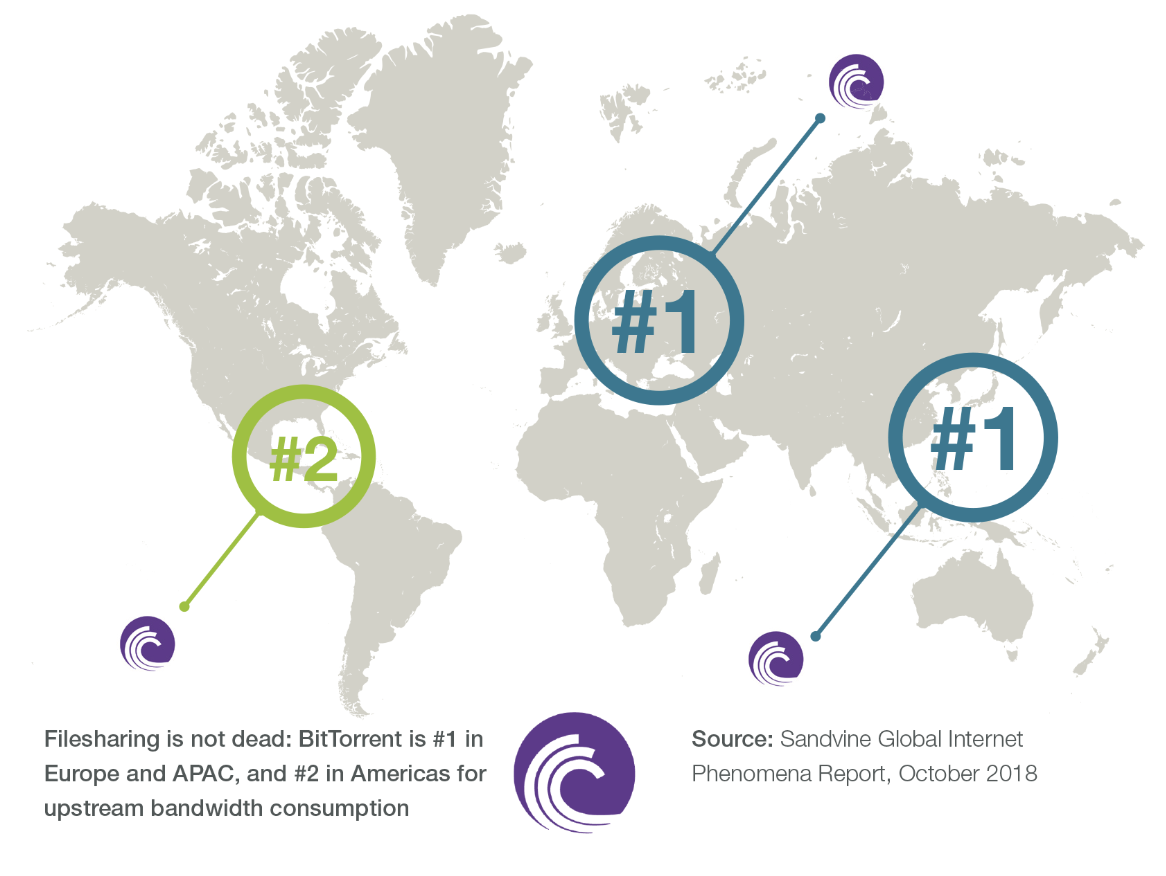A new study shows that after years of declines, BitTorrent usage and piracy is on the rise again. The culprit: an increase in exclusivity deals that force subscribers to hunt and peck among a myriad of streaming services to actually find the content they’re looking for.
Sandvine’s new Global Internet Phenomena report offers some interesting insight into user video habits and the internet, such as the fact that more than 50 percent of internet traffic is now encrypted, video now accounts for 58 percent of all global traffic, and Netflix alone now comprises 15 percent of all internet downstream data consumed.
But there’s another interesting tidbit buried in the firm’s report: after years of steady decline, BitTorrent usage is once again growing.
Videos by VICE
According to Sandvine, file-sharing accounts for 3 percent of global downstream and 22 percent of upstream traffic, with 97% of that traffic in turn being BitTorrent. While BitTorrent is often used to distribute ordinary files, it remains the choice du jour for those looking to distribute and trade copyrighted content online, made easier via media PCs running Kodi and select plugins.

Back in 2011, Sandvine stated that BitTorrent accounted for 52.01% of upstream traffic on fixed broadband networks in North America. By 2015, BitTorrent’s share of upstream traffic on these networks had dipped to 26.83 percent, largely thanks to the rise in quality, inexpensive streaming alternatives to piracy.
But Sandvine notes that trend is now reversing slightly, with BitTorrent’s traffic share once again growing worldwide. That’s especially true in the Middle East, Europe, and Africa, where BitTorrent now accounts for 32% of all upstream network traffic.
One major reason for BitTorrent’s rising popularity? Annoying exclusivity streaming deals.
“More sources than ever are producing “exclusive” content available on a single streaming or broadcast service—think Game of Thrones for HBO, House of Cards for Netflix, The Handmaid’s Tale for Hulu, or Jack Ryan for Amazon,” Sandvine’s Cam Cullen said in a blog post.
“To get access to all of these services, it gets very expensive for a consumer, so they subscribe to one or two and pirate the rest.” Cullen said.
As more and more companies jump into the streaming race, they’re cordoning off “must have” content into a wider and wider array of exclusivity silos.
Disney, for example, will soon be pulling most of its fare from Netflix as it launches its own streaming service this year. Studies have shown that nearly every major broadcaster will have launched their own streaming service by 2022. And these companies are increasingly choosing to keep their own content as in-house exclusives in order to drive subscriptions.
On one hand that makes sense. Numerous streaming providers are now winning awards for the original, usually-exclusive content they develop in house in a bid to reduce content licensing costs. The better, more exclusive your content is, the more subscribers you can drive to your service.
The problem: consumers only have so much disposable income, and the growing laundry-list of services users now need to subscribe to if they want to watch all of their favorite movies and shows can not only become confusing, but prohibitively expensive. That’s especially true overseas, where geographical viewing restrictions hamper access to popular U.S. content.
As a result, these users are starting to drift back to piracy.
Keep in mind that BitTorrent usage numbers are likely higher than Sandvine estimates, given the high number of users that hide their BitTorrent traffic behind proxies and VPNs to not only dodge the prying-eyes of their ISPs, but avoid copyright trolls and industry lawsuits.
The content industry spent years trying to battle piracy via all manner of heavy handed-tactics and lawsuits, only to realize that offering users inexpensive, quality, legitimate services was the best solution. Many users flocked to these services because they provided a less-expensive, more flexible alternative to traditional cable.
Now, if the industry isn’t careful, it could lose a sizeable chunk of this newfound audience back to piracy by making it overly expensive and cumbersome to access the content subscribers are looking for.
More
From VICE
-

Fujifilm X100VI – Credit: Fujifilm -

Indecision suuuucks – Credit: Jacobs Stock Photography Ltd via Getty Images -

Screenshot: Shaun Cichacki -

Photo: Getty Images
